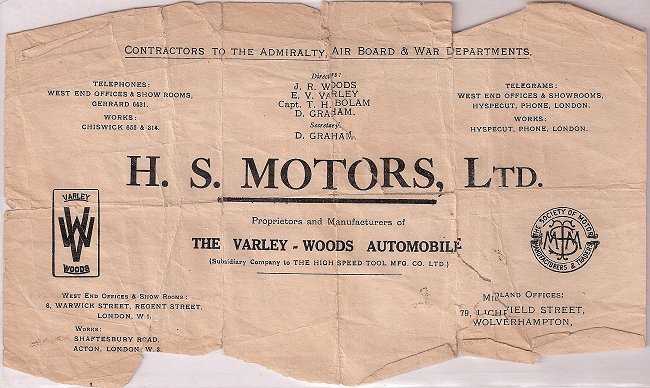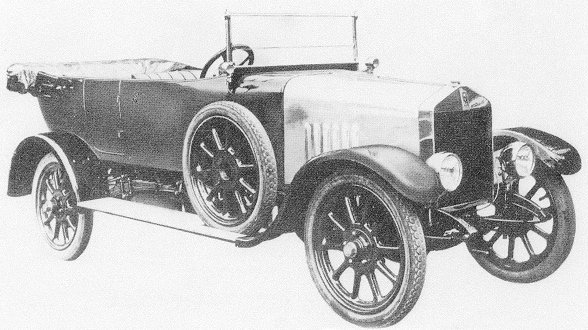|
This is a unique story in the annals of the
British car. It is a tale of an entrepreneur and an adventurer, who
stood up in the face of adversity, in an attempt to fulfil their
dream.
Varley-Woods cars were the product of Ernest
Vernon Varley Grossmith and Robert Woods, two entrepreneurs who seem
to have had more enthusiasm than business ability. Varley was a
member of the Grossmith family, many of whose members were
associated with both perfumery and the arts, particularly as singers
in light opera. Two of them, George and Weedon Grossmith also found
fame as the authors of "Diary of a Nobody", a satire on the life of
the aspirational lower middle classes, which still has great appeal
today. Around 1918 Varley dropped the surname Grossmith because of
the anti-German feeling at the time, and became Ernest Vernon
Varley.
He had a somewhat eccentric business career,
selling Government surplus goods, and being involved with the
manufacture of tinned soup and mouth organs. He somehow got into a
business partnership with Jack Storey, works manager of the Storey
Machine Tool Company of New Cross, London. He also owned Park garage
in Clapham, near to where Varley had his business. The Storey
Machine Tool Company was run by Jack Storey’s brother Will, who also
had a factory in Tonbridge, Kent. Varley and Storey planned to
produce a car, to be called the Winchester, but nothing came of it.
Around 1919 the Storey Machine Tool Company
began to produce the Storey car, but Jack left the company after
falling out with his brother. The company went into liquidation in
1920 and a receiver was appointed. Jack quickly hired a fleet of
lorries and stole a large number of components before the receiver
had chance to sell them. He took them to his garage where he
assembled a number of Storey cars.
In 1918 Ernest Vernon Varley, and two partners,
C. and D. Graham founded the High Speed Tool Company. They acquired
an empty laundry in Shaftesbury Road, Acton, and a nearby wooden
workshop in Hanbury Road. They began with a capital of £5,000, and
obtained a £35,000 mortgage for the property from the London City
and Midland Bank. This also provided working capital for the
project. Unfortunately the business soon failed and was sold off in
1921 for £5,000.
One of the shareholders of the High Speed Tool
Company was John Robert Woods, an adventurer and merchant who had
been making a living trading up and down the rivers of the near
east. In October 1918 Varley resigned from the High Speed Tool
Company, and in July 1919 joined forces with Woods to form H. S.
Motors (High Speed Motors) to produce the Varley-Woods car.
Captain Thomas Henry Bolam, a dental surgeon,
provided extra capital for the venture, in exchange for 999 one
pound shares, and acquired the premises and machinery of the High
Speed Tool Company, in Shaftesbury Road, Acton.

Courtesy of Tony White.
|
|
The early cars built at Acton possibly used
some components from the Storey car, but the company soon got into
difficulties with unfulfilled orders and rising debt. As a result
Varley and Woods decided to move to Wolverhampton, near to the
Turner Manufacturing Company, which made chassis for the Varley-Woods
cars.
Things rapidly went from bad to worse when the
unpaid creditors took the company to court, and called-in the
bailiffs. The bailiffs arrived at the factory, noted what was of
value, and padlocked the premises, stating that if the bills were
not paid within seven days, they would return and take everything
away to be sold-off.
Varley and Woods were not people to hang
around. They planned a ‘moonlight flit’ before the bailiffs could
return. They arrived at the back of the premises with a lorry, and
knocked a hole in the wall that was big enough for the lorry to
drive through. They removed every item of value, and prised the
machine tools from their concrete mountings with a pick axe. It’s
not difficult to imagine the anger when the bailiffs returned to
find everything gone.
The company also had a London showroom in
Warwick Street, off Regent Street, which they continued to use,
making no attempt to change the name of the car, or disguise it in
any way. This is incredible considering that they had a court order
against them, and even more incredible because it seems that when
the bailiffs had come and gone empty-handed, Varley and Woods
continued to use the Acton premises as a service department. |

A Varley-Woods 14.3 hp. tourer.
|
They acquired new premises at 79 Lichfield
Street, Wolverhampton, next to what was the Sir Tatton Sykes pub on
the corner of Fryer Street. The premises was possibly ideal because
it had previously been a car and cycle showroom, with repair
facilities at the back, and a rear entrance into Short Street.
As already mentioned, Turners supplied the
chassis, and Dorman of Stafford supplied the KNO 11.9 hp., 1,794
c.c. engines, which had an aluminium block. The transmission was via
a Varley-Woods gearbox, and an inverted cone clutch. The design of
the front end was based on a standard Rolls Royce, with a polished
aluminium bonnet, and an almost identical radiator. The car was
equipped with Sankey Artillery wheels, and the bodies were typical
for the time.
The cars were launched at the 1919 Motor Show
at Olympia. There were three models, a 2-seater, priced at £540, a
4-seater tourer, priced at £660, and a coupé, priced at £760. The
cars were not a success, and the company’s financial problems
increased. As time went by, it seems that more and more of the work
on the cars was carried out by Turners in Lever Street.
For the 1920 Motor Show, the cars were
displayed with a larger Tylor 14.3 hp. engine, possibly to improve
performance, or to save costs, or even because their credit had run
out with Dorman. The new models were displayed at White City, but at
far higher prices than before. The 2-seater was now priced at £695,
the tourer, £725, and a limousine at the incredible price of £1,200.
As the earlier and cheaper cars didn’t sell, it
should have come as no surprise to find that the new and more
expensive models didn’t sell either. The company’s debts spiralled
out of control, and the Lichfield Street landlord, and Turner’s
themselves presented a petition for the winding up of the Varley-Woods
company. A receiver was appointed in October 1920. It seems possible
that Turners had been building the cars in their entirety for some
time. They were still trying to sell remaining models in 1921.
Varley and Woods left Wolverhampton. Ernest
Vernon Varley moved to a cottage in Cornwall where he undertook his
last venture in the motor business. He reconditioned small engines
and fitted them to ‘stop me and buy one’ ice cream tricycles. John
Robert Woods returned to his previous life as an adventurer, trading
up and down the rivers near to Lake Nyasa, where one day he was
attacked and eaten by a lion.
In reality their venture into car making was
probably doomed from the start because of continuous cash flow
problems. When cars were ordered, they were often never delivered,
possibly because the business had run out of credit with some of the
component suppliers.
At least one Varley-Woods car has survived. It
resides in Shropshire, and is a typical product of the early 1920s,
no better or worse than many others. |
Thanks to Brian Rollings and the late Jim Boulton for
some of the
information on this page, and Tony White for the image. Information also comes from the Complete Encyclopedia of Motor Cars, G. N. Georgano (ed), 1985 edition.
|
|

